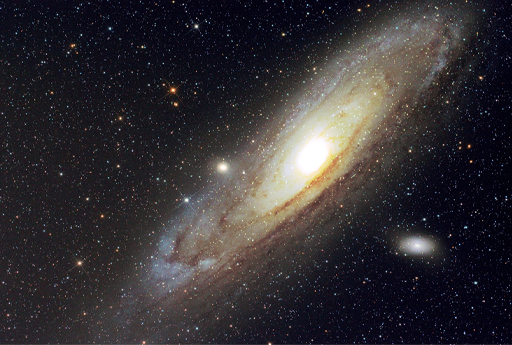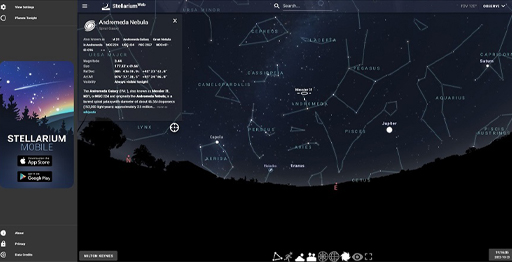2 How far can we see?
Gazing into the sky might make you feel like space goes on forever, but in one sense, we know it cannot. When you look out into space, you’re looking back in time. How can this be? It’s because light takes time to get to us, and everything you see carries information from the past, not the present.
Box 1 Distances in space
Light and other types of electromagnetic radiation (e.g., radio waves) travel through space at precisely 299 792 458 metres per second (m s-1), commonly approximated as 300 000 000 m s-1 or, in scientific notation, 3 × 108 m s-1. In one year, light will travel 9.46 × 1015 m – this distance is known as a light-year (ly). In other places you may see astronomical distances measured in parsecs, where one parsec is about 3.26 ly, but this course will mainly use light-years.
The light coming to us from the Moon started out about 1.3 seconds ago. When the Apollo astronauts were exploring the Moon between 1969 and 1972, the controllers on Earth had to wait almost three seconds for a reply. That was the minimum time it took for radio waves – travelling at the speed of light – to reach the astronauts on the Moon, and for their reply to come back to Earth.
Likewise, we see the Sun not as it is now, but as it was over eight minutes ago. We see the nearest star, Proxima Centauri, as it was 4.2 years ago. We see the centre of our own galaxy, the Milky Way, as it was about 27 000 years ago, when our Stone Age ancestors were painting animals on the walls of caves in what is now France.
The nearest large spiral galaxy similar to our own is known as Messier 31 (M31). It is the largest member of our Local Group of galaxies. You may have seen pictures of it (Figure 3), but did you know that on a dark night you can see it yourself without a telescope?
M31 is in the constellation of Andromeda. Although this is in the northern sky, it’s visible at some time from most parts of the world. It is more difficult to see from southern latitudes though.
The galaxy is best seen in dark skies when the Moon is absent. The very best views will be in autumn from the northern hemisphere but it can be glimpsed at other times of year, depending on your latitude. In the spring it is too close to the Sun in the sky to be seen at all.
In this activity you’ll use the Stellarium Web online sky chart to see if M31 is visible from your location, and find out the best time to look for it.
Activity 1 Glimpsing Andromeda
Follow these steps:
- Go to the Stellarium Web [Tip: hold Ctrl and click a link to open it in a new tab. (Hide tip)] website. If you are happy for the site to access your location, allow it to do so. Otherwise click the location button at the bottom of the screen and find your position on the map. Then click ‘Use this location’.
- You will now see a view of the sky from the place you have chosen (it may be in daylight, of course). From the box at the bottom right of the screen you can set the date and time to display the sky at any time you wish. Today’s date and soon after nightfall would be a good choice to start with.
- To find the Andromeda galaxy, type ‘M31’ in the search box at the top of the screen. From the drop-down list select ‘M 31 (Andromeda Nebula)’.
- The chart will then adjust to put M31 near the centre of the screen together with some information, including when it will rise and set. Use these times to set the chart to a convenient time when M31 will be above the horizon during the night.
- On a date and time when M31 will be visible in a dark sky, go outside and use the nearby constellation patterns to identify where to look. (If it helps, try turning on the constellation outlines with the button at the bottom of the screen.) The galaxy is just visible to the unaided eye as a misty patch, but it’s much clearer through binoculars. If you glimpse it, congratulations! You are seeing light that started on its journey 2.5 million years ago.
M31 is the most distant object visible to the unaided eye. So, if someone asks how far you can see in the dark, you can now give the answer: 2.5 million light-years.


